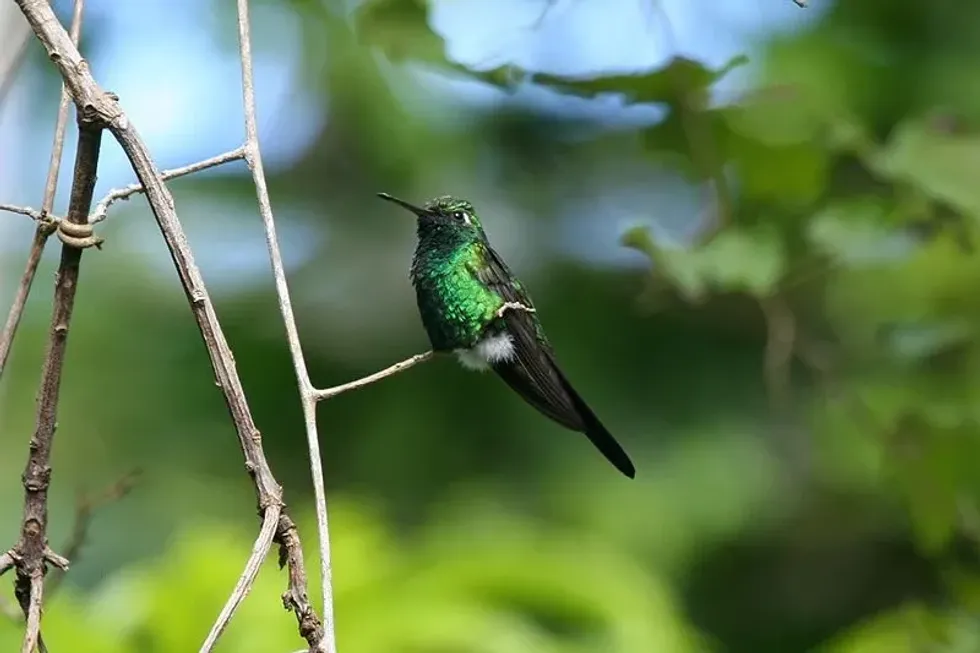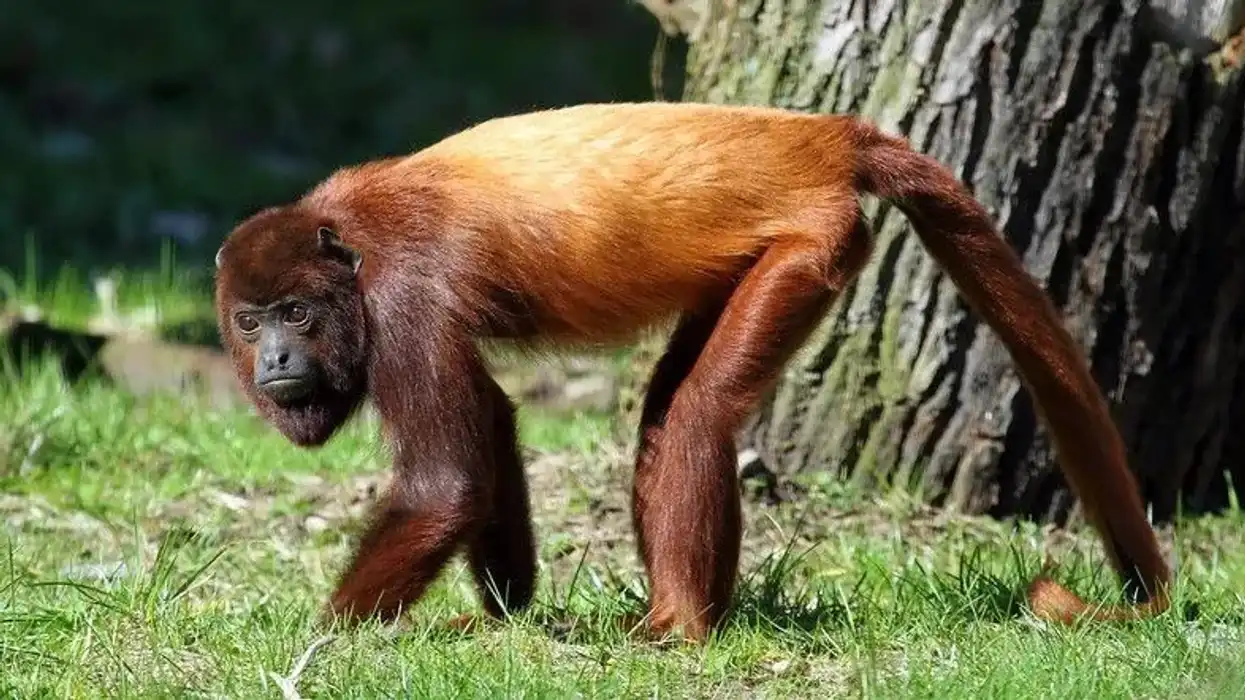It is interesting to note that hummingbirds are the largest family of birds having about 338 species of beautiful and fascinating birds. There are only two species of hummingbirds that inhabit Cuba and its neighboring islands; the Cuban emerald and the bee hummingbird.
The Cuban emerald is the larger green-colored bird of the two species. Cuban emeralds (Chlorostilbon ricordii) are majestic birds that are indigenous to Cuba, Turks, and the Bahamas.
Even though small, they are amongst the bigger birds of the hummingbird family. These birds are solitary flyers and do not live or migrate in flocks or with other birds.
They only come together for copulation and separate soon after. These birds are most commonly found in Cuba, and may even be found in neighboring island places searching for food or a breeding place.
The hummingbirds can fly quickly and swiftly because of their ability to gain momentum of 80 flaps per second. These birds are the only birds who can change their directions swiftly and can fly right-left, up-down, forward-backward, and even upside down.
Read more to learn about the other fascinating facts about these beautiful birds.
For more relatable content, check out these royal penguin facts and birds of paradise facts for kids.
Cuban Emerald Interesting Facts
What type of animal is a Cuban emerald?
The Cuban emerald (Chlorostilbon ricordii) is a bird that belongs to the hummingbird family.
What class of animal does a Cuban emerald belong to?
Chlorostilbon ricordi (Cuban emerald) belongs to the Aves class of the Animalia kingdom.
How many Cuban emeralds are there in the world?
The number of Cuban emeralds (Chlorostilbon ricordii) living in this world has not been estimated. However, they are commonly spotted in their natural range of semi-open habitats.
Where does a Cuban emerald live?
Hummings are largely found in North America, the Caribbean, and South America. As the name suggests, the Chlorostilbon ricordii (Cuban Emerald) are widely found in Cuba, the Grand Bahamas, islands of Abaco and Andros, Isle of Pines, San Andres, and Cayo Largo.
In these places, they are commonly found in a wide range of semi-arid places with ample vegetation. Besides, in the Bahamas, they are commonly found in the coastal scrub forests.
What is a Cuban emerald's habitat?
Chlorostilbon ricordii (Cuban emerald) are usually found in a wide range of semi-arid places 4265 ft (1300 m) above sea level and places with plenty of vegetation. These neotropical birds live in plantations, parks, gardens, and scrub forests.
Who does Cuban emerald live with?
The Cuban emerald hummingbird prefers to live in solitary for most of its life, except for the breeding time.
How long does a Cuban emerald live?
The longevity of a Cuban emerald hummingbird living in North America is not known explicitly. However, because it belongs to the family of hummingbirds, it would be safe to conclude that the average lifespan of this hummingbird would be three to five years.
How do they reproduce?
The Cuban emerald (Chlorostilbon ricordii) lives alone, which means they neither live nor migrate with other birds. The male and female birds come together only to copulate.
The male's involvement with the female is only till they copulate, after which they immediately separate. The female bird is solely responsible for building the nest in which she lays her eggs and incubates them for 15-16 days.
The average clutch size is two eggs.
When the eggs hatch and chicks are born they are immobile and blind like most chicks and are taken care of by their mothers who protect and feed their chicks.
The nectar does not have sufficient nutrients for the chicks to grow, thus, the females feed partially digested insects directly down the throats of the chicks into their stomachs with their bills.
The female brood its chicks for about two weeks. The chicks leave the nests when they are 20 days old.
What is their conservation status?
The conservation status, as declared by the IUCN red list, for the Cuban emerald (Chlorostilbon ricordii) is of Least Concern.
Even though the population trend of this species is not available but the number of this species is not believed to be decreasing to the limit of extinction which is a 30% decline in the population within the last 10 years.
Cuban Emerald Fun Facts
What do Cuban emeralds look like?

Cuban emerald (Chlorostilbon ricordii) is the larger of the two birds of the hummingbird family living in Cuba and is two and a half times bigger than the bee hummingbird. It is a dark green hummingbird with shimmery feathers.
There is a slight difference between these male and female Cuban birds. Both the genders have a short bill with the lower beak being red-colored and the upper beak being black with a black tip.
It has two-colored plumage of dark green and glossy green with a tint of metallic blue. The under tail features is white. Males have forked tails while females have slightly less pitched tails.
Additionally, the females have white flanks with the brownish-grey color of the below plumage. Lastly, both genders have a whitish spot behind the eye.
How cute are they?
Both male and female, Chlorostilbon ricordii (Cuban emerald) are extremely cute species. They are fascinating to watch because of their colorful and bright plumage.
How do they communicate?
The Chlorostilbon ricordii (Cuban emerald) bird communicates through speaks which are high-pitched sounds. It is through these sounds that the male attracts the female for breeding.
The voice of birds is known as a song, the male song is a series of 'slee' notes, while the female produces a 'see' flight call. The female bird is quieter than the male bird.
How big is a Cuban emerald?
The Chlorostilbon ricordii (Cuban emerald) species, of the genus Chlorostilbon, is the larger of the two birds of the hummingbird family living in Cuba. They are about 1.4-1.7 in (3.7-4.5 cm) in length while the other species of hummingbirds native to Cuba, the bee hummingbird, is about two and a half times smaller than the Cuban emerald.
When compared to a Western bluebird, they are much shorter in size.
How fast can a Cuban emerald move?
The Cuban emeralds (Chlorostilbon ricordii) are extremely fast birds just like other birds in the family and genus, Trochilidae and Chlorostilbon respectively. They can flap their wings 80 times per second which makes them extremely fast. A hummingbird is the only species that can fly upside down, left-right, up-down, and even backward.
How much does a Cuban emerald weigh?
Like other birds in the genus Riccordia, the Cuban emerald (Chlorostilbon ricordii) is one of the two lightweight birds of Cuba having an average weight of 0.1-0.2 oz (3.4-5 g). This bird weighs much less than an average mockingbird.
What are the male and female names of the species?
The scientific name of male and female, Cuban emerald (Chlorostilbon ricordii) is the same, however, generally, male birds are called cocks and female birds are called hens.
What would you call a baby Cuban emerald?
The babies of Cuban emerald (Chlorostilbon ricordii), like other birds, are called chicks.
What do they eat?
As adults, the Cuban emerald (Chlorostilbon ricordii) birds feed on the nectar of flowers and blossoms. On the other hand, the chicks are fed half-digested insects for nutrients by their mothers.
Are they poisonous?
No, the Cuban emerald (Chlorostilbon ricordii) bird is a non-poisonous species.
Would they make a good pet?
The Cuban emerald (Chlorostilbon ricordii) belonging to hummingbird species should not be kept as pets. A hummingbird cannot survive in enclosed areas.
Besides, we cannot provide the nectar and insects which these species feed on. However, one can keep a feeder in the lawn and gardens to attract these birds that are indigenous to Cuba, Turks, and Bahamas in North America.
Did you know...
They are such fascinating birds, they are popular in the research field as well. To understand the changing pattern of breeding conditions of the birds, numerous scientists have appointed volunteers of the lab of ornithology to monitor their nests.
A few years ago, these fascinating creatures were also poached for their shimmering feathers. Today, they are also threatened because of the destruction of their habitats due to human activities and climate change.
It is also important to understand and raise a voice against climate change, because of the changing climate these beautiful species are forced to migrate to places well beyond the Cuban emerald range map.
Are they endangered?
The Cuban emerald, (Chlorostilbon ricordii), is not an endangered species, the IUCN Red List has declared the Cuban emerald as of Least Concern because their population trend has not demonstrated a rapid decline in the last 10 years.
Are they predators?
The Cuban emerald (Chlorostilbon ricordii) (french name: émeraude de Ricord), feed mostly on nectar on flowers in the range of semi-open areas. They only feed on insects as young chicks. Thus, this species should not be called predators.
Here at Kidadl, we have carefully created lots of interesting family-friendly animal facts for everyone to discover! Learn more about some other birds from our toucan bird facts and eagle facts pages.
You can even occupy yourself at home by coloring in one of our free printable cuban emerald coloring pages.









